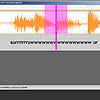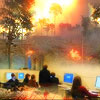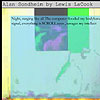 Originally
published
on
05/07/03
Originally
published
on
05/07/03The questions are abundant on Mediatopia.net. Through a striking opening and an average interface, the site reveals a multitude of topics ranging from government intelligence gathering to digital love. Tensions are exposed and desires embellish theories of cyberspace. Ideologically charged electrons paint a flesh filled world of vanguard reflections. Artists represented include: Michael Alstad, Anonymous, Kate Armstrong, Lara Bank, Andrew Bucksbarg, Jeremy Hight, Catherine D'Ignazio, Wolf Kahlen, Jeff Knowlton, Shirin Kouladjie, Naomi Spellman, Stanza, Geoff Thomas and Jaka Zeleznikar. Writers are also represented; they include: Linda Carroli, John Grech, Eduardo Navas, Brian Walsh, as well as authors who contributed anonymously.
The discourse is omnipresent in all pixels.
:: Ludmil Trenkov ::
 Originally
published
on
05/07/03
Originally
published
on
05/07/03Numero Verde is a new media piece that intrudes on the privacy of cell-phone users, even weeks after the service may be thought of having stopped. The project was developed for the art community, but it is mainly aimed at the everyday person.
Simultaneously working in the art world and the everyday community has always been an odd space in which to develop art. The reason for this is due to the necessary contextualization that any art practice relies on in order to be contemplated -- that is, in the privileged realm of aesthetics, which does not always meet the practical demands of everyday reality. In Numero Verde, the phone users, who become the subjects of contemplation, may find the obtrusion of their privacy simply insulting, while the privileged viewers (a.k.a. the art community) are able to consider the cell-phone performances intriguing because it exposes the vulnerability of private life. Numero Verde can inevitably be considered elitist, thereby creating a friction between the subjects (or unaware performers of the piece) and the privileged audience who is entertained. This is an issue that comes up with all public performances, and it is definitely being pushed to the edge in the cell-phone project.
Artist: Luca Bertini
:: Eduardo Navas ::

The Java Museum presents a diverse group-exhibit of contemporary Latino net artists in Netartlatino.net, found here.
The work of 48 artists from Latin American countries is represented through a variety of visual and conceptual approaches. Works include Flash animation and interactive fare, Shockwave, Java, HTML and web works, RealPlayer, and Quicktime movies. Each artist is showing between one to three net art pieces.
The exhibit is vast, but it will offer a glimpse into the mindsets of individual artists from different Latin countries all sharing a common heritage.
The interface imagery chosen is a bit stereotypical (a burning jungle) and the site's curatorial and instructive text could stand to be more clear, but at the end of the day, it is the dialogue between this global community of Latino net artists that makes this exhibit one not to miss.
:: Kristen Palana ::
 Originally
published
on
05/02/03
Originally
published
on
05/02/03Continuing the line of thought that a lot of new media art, especially net art, plays on the idea of remixing either existing work or culture, Alan Sondheim by Lewis LaCook is both an interpretation of an original idea by Alan Sondheim--implemented here by Lewis LaCook (obviously) as a result of a conversation between the two artists--and a remix of the sort of styles used by Alan in his work.
Lewis is a regular contributor to Net Art Review so it's good, for a change, to cast a critical eye over the work that's being created by us (the regular contributors) rather than others. Both artists work extensively with text / code in a poetic sense and are good examples of the philosophy of code as language/language as code that lies at the heart of much net art and still manages to inspire net artists. Lewis and Alan can be seen regularly on lists such as _arc.hive_.
:: Garrett Lynch ::